Common Ferns in Coastal Humboldt and Del Norte Counties
Text based on the annual fern walk along the entrance road to Lanphere Dunes the last weekend of April
by Carol Ralph
April 2020
[Parts of this article were in an article in Econews, April-May 2020]
Most people love ferns in general but have not paused to separate the various fern species among the green blur. Around Humboldt Bay this is not hard to do. Here is a quick guide.
First, how do you know it's a fern? Some flowering plants, like Yarrow, have "ferny" leaves; some ferns have "unferny" leaves. Only ferns have fiddleheads, the uncoiling tips of developing fern leaves. And ferns do not have flowers or seeds; they have spores, tiny, dust-sized reproductive cells produced in sporangia. Sporangia are usually on the underside of the frond, usually clustered into brown spots or blotches (called sori) that are visible to the naked eye. Sporangia are helmet-shaped capsules that open and fling the spores into space. They are light green while they develop and brown when mature. They remain on the frond, visible, even after the spores have dispersed. Not every frond produces spores. Different fern species produce sporangia at different times and in different patterns. In our ferns, sporangia may be hidden under a rolled leaf edge, clustered under a flap of leaf tissue, or sprinkled over the leaf underside.
In describing a fern it is useful to note whether it is creeping or tufted. If the fronds arise singly from the ground, the fern is creeping. Each frond is attached separately along a creeping stem (rhizome), which may be underground or on the surface. The rhizome is a snaking, root-like structure up to finger-thick. If the fronds arise from a central point, forming a pleasing, geometric pattern, the fern is tufted. The fronds are attached to the top of a vertical stem, like a tuft on a feather duster (or like a crown). It is also useful to describe the degree of "ferniness," how finely divided the frond is. Fronds may be merely deeply lobed, with rows of fingerlike lobes down each side, or the side-lobes (pinnae) may be lobed or divided again (twice divided) or even again (thrice).
The world's most widespread fern demonstrates the creeping habit and twice- or three-times divided fronds. Bracken (Pteridium aquilinum), sends up fronds singly from a creeping rhizome that is well underground. Its frond has a very tough leaf stem and is very "ferny." This is the only fern frond with tree-like architecture. The lower pinnae of the frond behave like branches of a tree, orienting separately from the main axis of the frond. Fronds can be 1-8 ft tall. They can be scattered through a light-canopied forest, like the dune forest, or packed together filling a meadow. Remember Christopher Robin walking crackling through the Bracken? It dies back for the winter, i.e. it is winter deciduous. Its dry, brown, old fronds betray its presence all year. Don't expect to find spores on these fronds. They must make them sometime, but I have rarely seen them, or rather, the curled-under leaf edge that hides the sporangia.
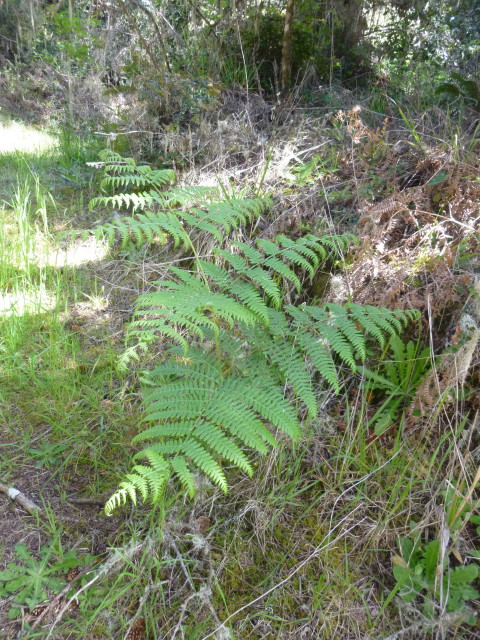 |
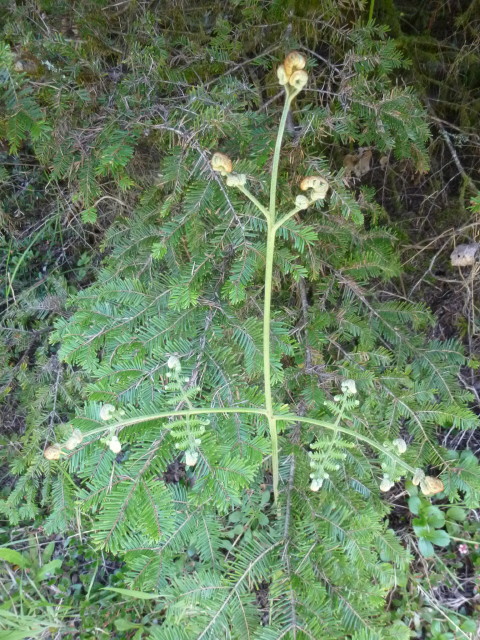 |
An abundant creeping fern covering roadbanks, rocks, even dune faces, in mats of tangled rhizome and root and a dense growth of 6-18" bright green fronds is Roadbank Fern (Polypodium calirhiza). (I'll confess to creating this common name. The name in official sources, Nested Polypody, was just too baffling.) Its fronds are very simple compared to Bracken, being once divided, like a single row of fingers down each side of the frond. The rhizome creeps on or just below the soil surface, easily seen as a 1/2-inch-thick, knobby, flakey, brown structure. Now, in April, Roadbank Fern is beginning to look slightly yellow and tired, and almost every frond has many round spots of empty sporangia on the underside. By the end of May, when so many plants in our area are at the peak of green vigor, Roadbank Fern is yellowing and drying. It has dropped its spores, and will be dormant for the summer dry season. It is summer deciduous, a good strategy in a Mediterranean climate, Soon after the first rains in fall, fresh, green fronds will emerge, a welcome sight after a dusty summer. The identification of Roadbank Fern was confused with California Polypody (Polypodium californicum) until in 1991 a study of these species plus Licorice Fern (Polypodium glycyrrhiza) revealed that Roadbank Fern originated as a hybrid between California and Licorice Ferns, and is now hardier and more widespread than either of those. Licorice Fern is similar but with pointier leaflets and favors lusciously mossy trunks of deciduous trees like Big-leaf Maple, where it usually can stay green all year. California Polypody does not occur this far north.
It turns out that ferns often hybridize. This and other wonders of the fern world are explained in A Natural History of Ferns by Robbin C. Moran, an entertaining and readable collection of essays. To understand why so much hybridization, picture the tiny spore, a dust-sized mote, released from the parent plant. If it is very, very lucky, it will land in a spot providing the moisture and nutrients to grow into the next plant. Surprise! This next plant is NOT a fern with fronds. It is generally a tiny, thin, green flake called a prothallus. This is the gametophyte generation of the fern. (Maybe you took biology and heard about the alternation of generations.) It produces gametes--mobile sperm and a confined egg. The next step, fertilization, requires water. This is why, even though some ferns can grow in dry habitats, they can not reproduce there. They need water for reproduction. The sperm are released into a film of water (rain, dew, seep, etc.) and swim to the egg. If several species of ferns are around, it is easy to see how swimming sperm could end up fertilizing an egg of a different species. Presto--hybridization!
That is the first step to a successful hybrid, but a second step is necessary. If the hybrid embryo develops at all, it usually results in a sterile offspring, like mules, hybrids of donkeys and horses. This is because chromosome pairing during cell division to make gametes can't match things up. The process that surmounts this obstacle is a faulty cell division, in which after chromosome doubling, all the chromosomes go to one of the two daughter cells. That cell now has the original and the duplicate chromosomes, which of course can match up during a later cell division. This faulty cell division is common enough it has a name--polyploidy. Now each chromosome has a mate, and cell division to produce gametes can proceed with successful results. Hybridization followed by polyploidy produced a new species! Like Polypodium calirhiza.
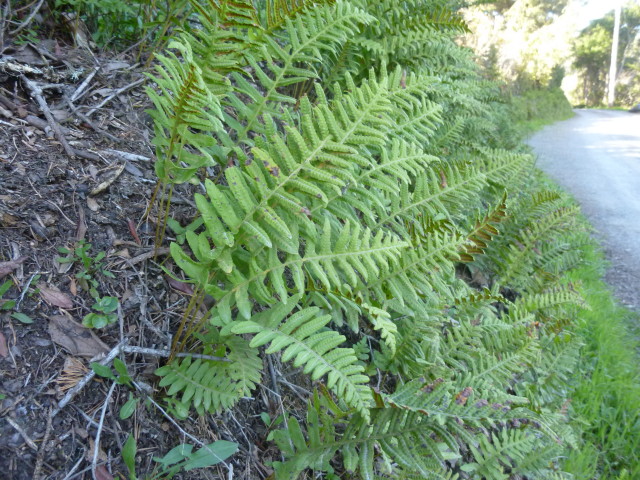 |
| Polypodium calirhiza - Roadbank Fern |
A taxonomically more stable, larger, tougher creeping fern is Leather Fern (Polypodium scouleri). Its fronds are singly divided, dark green, leathery, evergreen, and feature a prominent, rounded lobe on the tip. The circular spots of spores are on only some fronds and mostly on the outer half of the frond. Leather Fern grows as an epiphyte (on plants), including in the largest Redwoods, where thick mats of its creeping stems and tough leaves create huge islands of soil in the tree tops. A falling branch can carry with it a clump of Leather Fern, which will then grow on the forest floor.
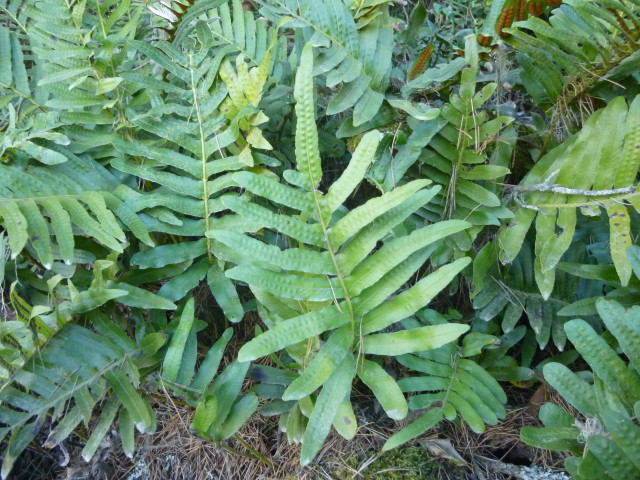 |
| Polypodium scouleri - Leather Fern |
The classic forest floor of Redwood forests is a lush growth of Sword Fern (Polystichum munitum). Its fronds are simply lobed, like the polypodies, but are arranged in a tuft than can grow very large. A gardener planting a cute, little Sword Fern may have to change plans ten years later, as the fern reaches 4-5 ft from the center in all directions. The leaflets are attached by just a corner to the leaf stalk and get gradually shorter toward the frond tip. Not all fronds produce spores. When they do, the spores are in tidy rows of circular spots down either side of a leaflet's underside. Sword Fern is hardy; it grows in dry conditions just fine.
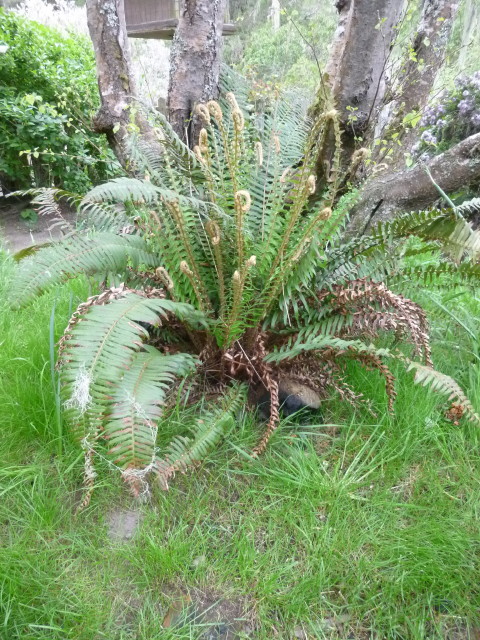 |
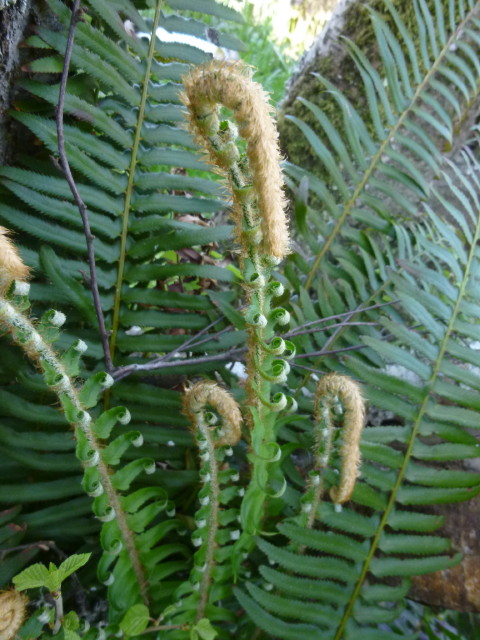 |
Also in shady forests and with simply lobed fronds arranged in a tuft, is Deer Fern (Struthiopteris spicant. formerly Blechnum spicant, Its taxonomy has been updated.). It can be most abundant on cut banks by a trail, road, or creek, where it is free of the dominant Sword Fern. Deer Fern is smaller and tidier than Sword Fern, with a circular crown of fronds. The entire leaflet base is attached to the leaf stalk, and the leaflets get smaller both toward the tip and toward the base. The spores are hidden in the scruffier, narrower reproductive fronds standing vertically in the center of the plant. All Blechnum ferns have these distinct, fertile fronds to produce the spores.
| Struthiopteris spicant - Deer Fern |
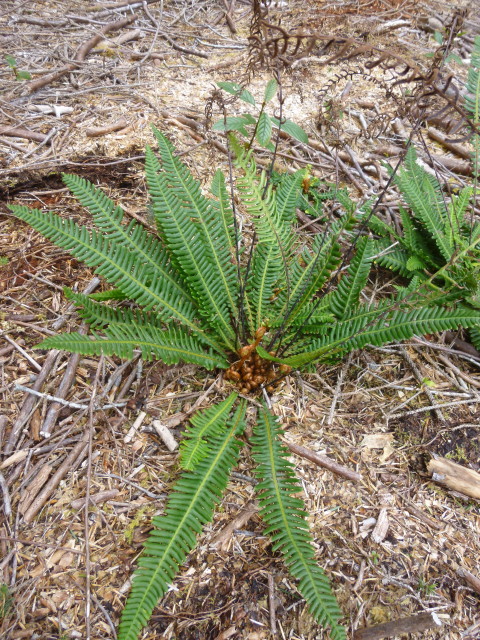 |
A more "ferny" fern, with finely divided leaves, in shady forests is Spreading Wood Fern (Dryopteris expansa), usually found on rotting wood, like stumps, fallen trunks, or piles of shed bark at the base of a tree. Its fronds have a triangular outline, meaning the longest pinnae are at the base. Its spores are in round spots. It is evergreen. These features distinguish it from the similar Lady Fern (Athyrium filix-femina), common anywhere moisture is found, in forests or out. Lady Fern's soft, bright green, finely divided fronds die every winter. Its fronds have a diamond-shape outline, meaning the longest pinnae are in the middle. Its sori are longer than wide. A large Lady Fern may have a short trunk and a large, lush presence.
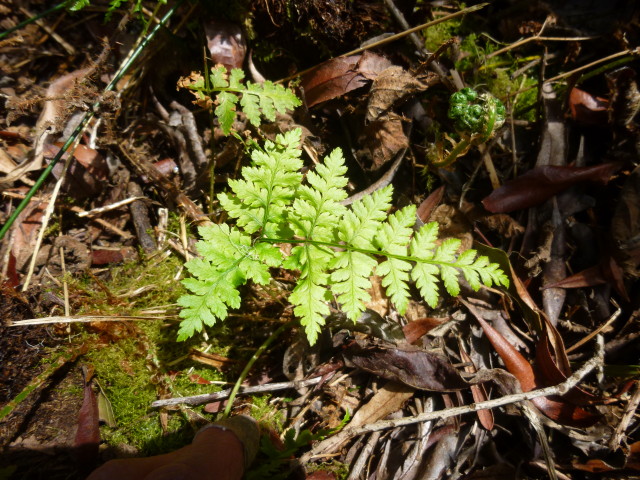 |
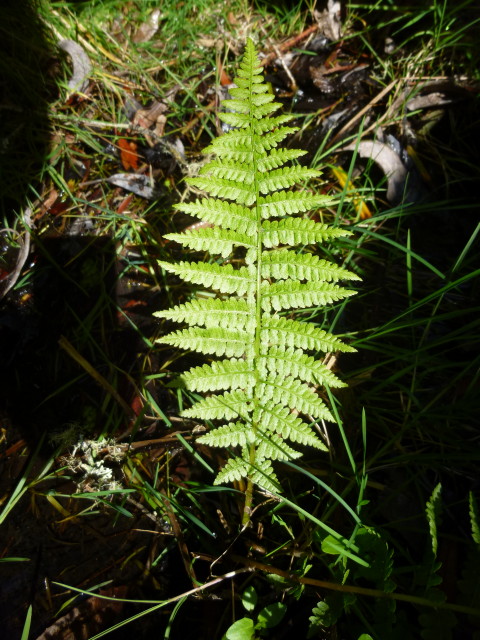 |
| Dryopteris expansa - Spreading Wood Fern | Athyrium filix-femina - Lady Fern |
A relative of Spreading Wood Fern that actually doesn't look much like it, is the widespread Western Wood Fern (Dryopteris arguta). This species grows in drier places, like inland or occasionally at edges of the dune forest. It's twice-divided, dark green fronds are evergreen, growing in a tight, somewhat disorganized tuft.
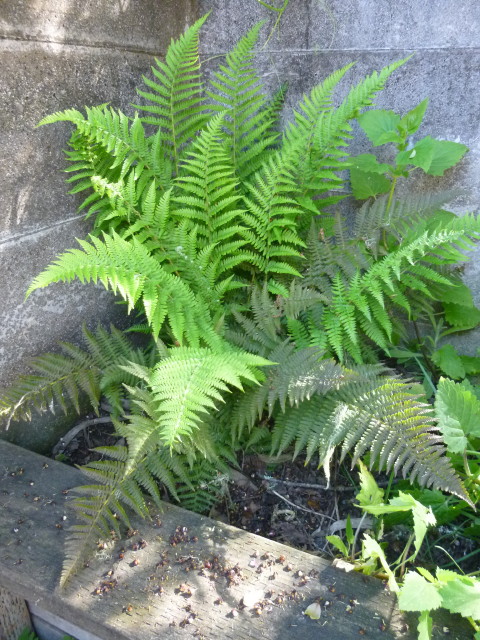 |
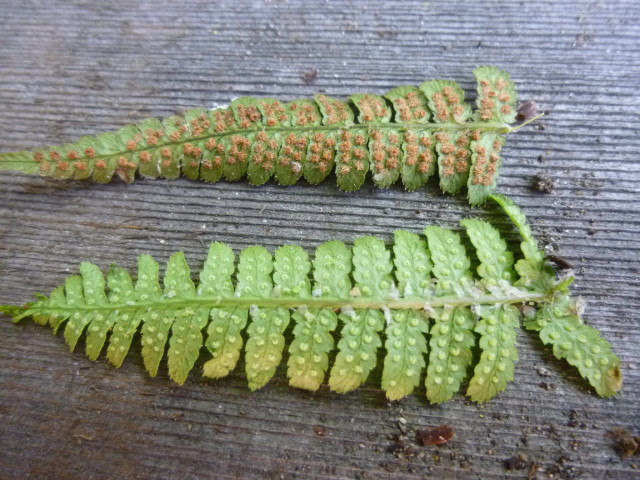 |
Five-finger Fern (Adiantum aleuticum) grows in damp but well drained, forested places, like the walls of Fern Canyon or a shady curve in a forest trail. Its many, dainty leaflets neatly arranged on delicate, wiry, black leaf stalks are guaranteed to elicit oohs and aahs. These leaf stalks are an important ingredient of Native Californian baskets. Despite its delicate appearance, Five-finger Fern also grows in serpentine rock jumbles along sunny mountain roads, a seemingly harsh environment. Don't look for spores in spots under these fronds. The spores are covered by flaps at the edges of the leaves.
Another species with a wiry leaf stalk is a fun, little fern encountered in apparently dry places, Goldback Fern (Pentagramma triangularis). It deals with dry periods by curling up its fronds, waiting for rain, which will make it open again. The underside of its triangular fronds is clear yellow, the color of a waxy powder. Tiny spore spots may be sprinkled all over the underside.
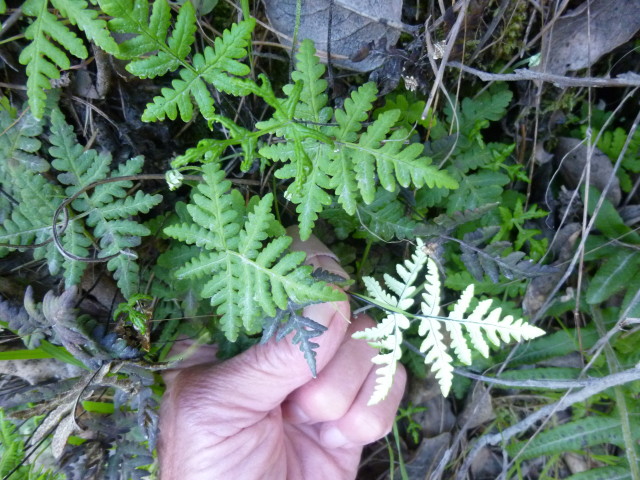 |
| Pentagramma triangularis - Goldback Fern |
In April all these ferns are green, and many of them are growing new fronds, demonstrating their fiddleheads. Earlier in the season the Bracken and Lady Fern will not be up. Later in the season the Roadbank Fern will be dry, and the Goldback Fern will be curled up. Right now is a great time for ferns, as well as for flowers!
All photos by author.

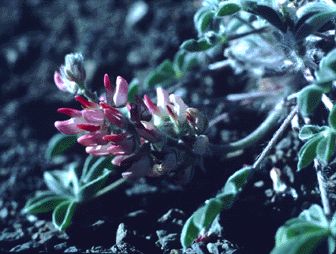
 Activities
Activities